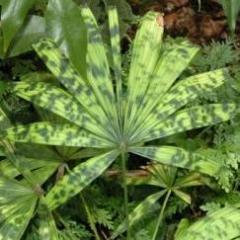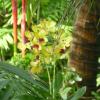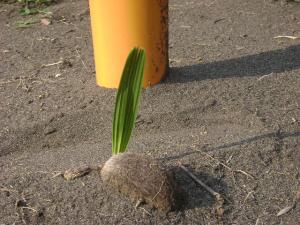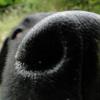Leaderboard
Popular Content
Showing content with the highest reputation on 04/09/2010 in all areas
-
Group, I know many of you are not real keen on Phoenix Palms, but I wanted to let you know I posted a new article at my site on Phoenix Palms and the Date Palm. I like this group of palms and found many people out there have confusion over what is a true Date Palm. I think the link below will take you to the article. Thanks for looking at it and feedback appreciated. Phil http://www.junglemusic.net/articles/DatePalms.html1 point
-
I don't see how the gloss of the culms can be a key to identification, as the glossiness fades over time with the constant friction of the culms rubbing against each other, due to wind, competitive growth and just plain weather wear with age. Older culms are usually flat and rough due in part to this reason, and they usually have old brown spots where they often touch. Another thing to consider is the effect of the light used in a bamboo photo compared to seeing the plant in person. A camera flash can really bring out a gloss, compared to just standing in front of it with daylight shining upon the plant. The appearance of gloss can also be augmented with added moisture, which I have done before to add shine to plants. Ryan1 point
-
- 11:16AM: The southern tip of that first island planting bed was anchored by this impressive American Oil Palm, Attalea sp. I looked through my Palms of Brazil book trying to identify it, and this palm strongly resembles Attalea speciosa. - The tour continued to move towards the backyard one palm at a time. I continued to photograph at a rapid pace, trying to capture everything while moving from palm to person, and back to palm. - 11:17AM: A quick sprint to the west side of the property revealed this relatively small, but still impressive Borassus flabellifer. I think this is one of Ron's favorite palm genera. - After I took the shot above, I looked towards the backyard and noticed Jeff Chait staring intently at something, so naturally I had to investigate. I walked over to the side gate to see him examining this very unique looking Attalea species. This one was also a mystery, and it resembled Attalea maripa in leaf form, inflorescence and seed. On the other side of the yard, I noticed tour goers moving through into the back yard, so we ran back over to join the group. Ryan1 point
-
- 11:14AM: These tours will bring out and reinforce the plant collecting and growing spirit in every enthusiast that attends. I heard all sorts of comments, conversations and statements referring to 'what to add to the want list' and 'I can't wait until my palm grows up to look like that one' and so on. A common side effect is cross group enthusiasm, when a unique plant of a certain family sparks interest in a new plant group to a palm fanatic, whether it be orchids, bromeliads, crotons, ferns, etc. The reverse is also true, as there were non-palm people on the tour who were getting a crash course to the world of palms, which could lead to addiction. - An old palm for sure, no doubt about that. This is a tall Coccothrinax miraguama subsp. havanensis. The leaves have a strong silver underside and are stiff and rigid. The leaf bases form a dense, interwoven fibrous surface that resembled something almost artificial. - 11:15AM: Zooming out, you can see just how tall this palm was. SFPS Director Lou Squros was standing next to it and videotaping the tour. - To the right of the Coccothrinax miraguama subsp. havanensis, was an equally tall Livistona decora and a grouping of Cuban Royal Palms, Roystonea regia. Tour Host Jeff Chait and collector Rosita Stoik were having a good time looking at the palms behind me. Ryan1 point
-
- 11:12AM: Ron mentioned how this bushy Pinanga sp. was growing unprotected, out in full blazing sun with no problems. - 11:13AM: I glanced over the fence gate leading to the backyard, to notice this fruiting Buccaneer Palm, Pseudophoenix sargentii up near the wall of the house. The inflorescence looked a little different than usual and I wondered if this was possibly the 'var. navassana' or the subspecies 'saonae'. - 11:14AM: "It looks like a large Kentia Palm (Howea forsteriana), but they don't grow in Florida, so it must be fake." - The mass of tour goers were still scattered around in the front yard. The majority had started to form a group, while following John around the yard in a clockwise fashion. They started in the NE corner and slowly headed towards the backyard. Ryan1 point
-
- 11:11AM: The Borassus aethiopum deserved another look and on closer inspection it was discovered to be in bloom, with different inflorescences emerging from all sides of the leaf bases. - The immediate area in front of the house was landscaped with an array of palms, ferns and low growing plants. It was kept sparse as to show off the style of the house, including the large windows and column-enhanced entryway. Jeff must have said something, as Andrea was stretching out her fingers, getting ready for a slap. - 11:12AM: A pair of Cuban Petticoat Palms, Copernicia macroglossa start growing upwards... - At first glance I thought this to be a Bailey Palm, Copernicia baileyana but it also resembles a C. gigas in size and appearance. It could be either species, as I could not get a confirmed ID from John. Ryan1 point
-
- 11:10AM: The island of palms extended back towards the house and had a nice selection of residents. At this point in the tour, most of us were exploring the front yard on our own; with a small group following owner John Greenleaf as he spoke about his favorite plant family, palms. An Old Man Palm, Coccothrinax crinita, dominated this point of the island. It was well grown and had a thick layer of hair. To the right is an unfortunate victim of the freeze, a Licuala grandis with heavy leaf damage, but still with potential for a comeback. - The oval bed at the front of the house was packed with palms, but still had plenty of room for more plants. This was a nice surprise as you don't see that many Pseudophoenix lediniana around in collections. John's entire yard was a propaganda poster for Caribbean palm species. It was by far, the most used palm group, as I am sure Ron would agree. - 11:11AM: A mere jaunt led Ron and I nearby to this glowing white Copernicia ekmanii. - Giants tend to travel in pairs, as there is often safety in numbers. Down the driveway from the Corypha utan was this oppressive Borassus aethiopum which in scale made Jeff Searle's adjacent Ford F-250 look like a toy truck. Ryan1 point
-
Well, it seems like months have passed since I placed an update for the Borassus seedling but it's only been three weeks! Time flies when you're having fun! The seedling has nearly doubled in size since the last post and this is the only one of the eight I have in my garden that is sending up a leaf. regards to all, Peter1 point
-
Hello Kris, I wanted to update you on my Corypha macropoda seeds. Five have germinated so far and I am giving the others some time before I take out the sandpaper! I planted one directly into the ground and a few others into a large black plastic pot (trash container really). I will post a pic of the Borassus seedling under a different post. warm regards, Peter This one in the ground is just starting to sprout. This is one that germinated a couple of months ago. You can even see the other one alongside.1 point
-
1 point
-
Wow, Peter - that's some location. Did your friend plan to make the video for any special reason, or just as a gift? Enjoyed it too.1 point
-
- 9:42AM: There was plenty of orchid goodness spread about the yard. There were examples of some orchids growing over and covering other ones. - Tour Goer: "Hmm.. that is one big palm." I walked back to the edge of the backyard and zoomed to the far corner of the yard, where I saw people examining a massive Talipot Palm, Corypha umbraculifera. It marked the back, NE corner of the property. - Standing in the same position and zooming out to normal view distance, you can see how far the palm was from the edge of the patio I was standing on. There were too many plants to see with the time allotted. - I headed back to rejoin the tour and came to the first planting bed filled with numerous bromeliads, palms and one coning Dioon spinulosum. Ryan1 point
-
- 9:41AM: "Wow... Simply wow..." In the stories that had filtered their way around the palm world, I had heard a few of them referring to Jeff Block and his "amazing specimen of that red palm". I always figured it was a Red Sealing Wax Palm, Cyrtostachys renda they were talking about, but was not sure, until now. - It was originally planted in this formed box planter in the shade, but has since grown (a lot) out into full sun with zero problems. There were signs of suckers and stolons being removed, evidence to the fact it would have grown even larger if it had the room to do so. It was a pleasure to just stand here and look at it. Many Red Sealing Wax Palms develop that 'blunt' look and gain a silvery hue to the bottom of the leaflets when grown in full sun over time. - I estimated the total height of the clump at around 15 feet (4.5m) tall with a 4 foot (1.2m) restricted spread. I forgot to ask Jeff Block if it had ever flowered, as I didn't find any evidence of maturity; although any old inflorescences would have long been cleaned off by now. This palm is more than old enough and large enough to flower at any time. - That brilliant red waxy coloring covered every crownshaft, extended through each petiole and up to the terminal end of every rachis. Doesn't this palm look great considering the fact it was exposed to the wind and a freezing low of 31ºF (-0.5ºC) without a scratch on it? Did it deserve to have four photos of it posted? Yes. Ryan1 point







